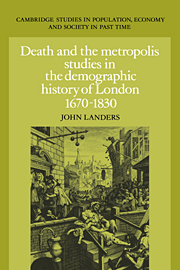Book contents
- Frontmatter
- Contents
- List of figures and maps
- List of tables
- Preface
- Acknowledgements
- Part I EIGHTEENTH-CENTURY LONDON AND ITS VITAL REGIME
- Part II THE LEVEL OF MORTALITY
- Part III DIMENSIONS OF LONDON'S EPIDEMIOLOGICAL REGIME
- 6 The seasonality of mortality
- 7 The instability of mortality
- 8 Spatial variations in mortality
- 9 Conclusion
- Appendices
- Bibliography
- Index
- Cambridge Studies in Population Economy and Society in Past Time
7 - The instability of mortality
Published online by Cambridge University Press: 05 November 2011
- Frontmatter
- Contents
- List of figures and maps
- List of tables
- Preface
- Acknowledgements
- Part I EIGHTEENTH-CENTURY LONDON AND ITS VITAL REGIME
- Part II THE LEVEL OF MORTALITY
- Part III DIMENSIONS OF LONDON'S EPIDEMIOLOGICAL REGIME
- 6 The seasonality of mortality
- 7 The instability of mortality
- 8 Spatial variations in mortality
- 9 Conclusion
- Appendices
- Bibliography
- Index
- Cambridge Studies in Population Economy and Society in Past Time
Summary
Mortality levels in London were not only much higher than in England at large, they also varied much less from year to year. In both these respects, the capital's demography reflected the underlying characteristics of a high potential mortality regime, and, given this, it may seem odd to devote an entire chapter to the ‘instability of mortality’. The importance of such instability lies not, however, simply in its absolute magnitude, or quantitative contribution to the secular level of mortality, for – as we saw in chapter 1 – historical demographers have often looked to this variable as an interpretative key to the mechanisms of secular demographic change.
The original expectations of crisis theory concerning mortality decline and ‘stabilisation’ may not have been borne out, but we can still hope – as Post's work (1984; 1985; 1990) implies – to gain particular insights into the internal structure of a demographic regime by studying its reaction to exceptional stress. In this context we are especially interested in the relative importance of changes in resistance and exposure to infection – and in the determinants of the latter – in generating excess mortality.
At the same time, the analysis of statistical relationships between vital series, and a variety of economic and climatic data, underlies the econometric approach to historical demography which has contributed powerfully to the establishment of neoclassical theory. Of central importance here is the conceptual distinction between highand low-pressure demographic regimes and the attempt to identify such regimes in practice.
- Type
- Chapter
- Information
- Death and the MetropolisStudies in the Demographic History of London, 1670–1830, pp. 242 - 300Publisher: Cambridge University PressPrint publication year: 1993



